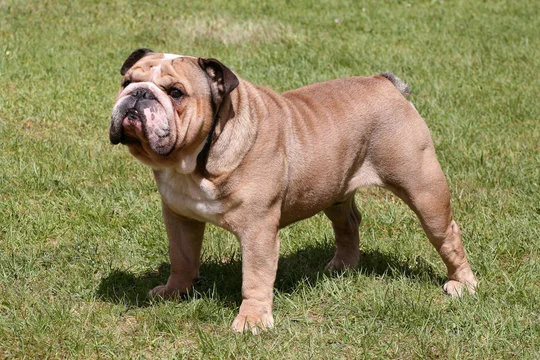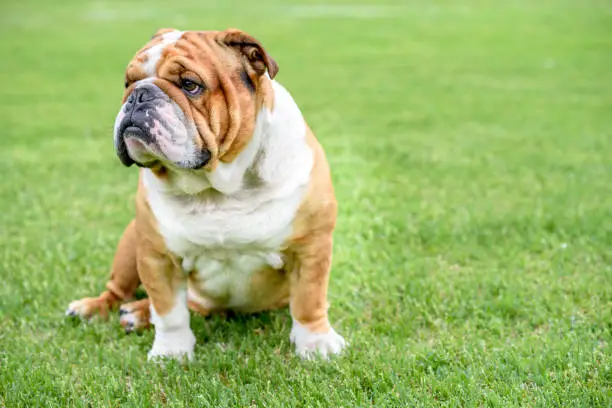History
The English Bulldog, a breed that stands as an emblem of tenacity and loyalty, has a storied history dating back centuries. Originating in England, the breed’s roots can be traced to ancient bull-baiting contests, a cruel sport that pitted dogs against bulls in a test of strength and courage. Bulldogs were selectively bred for their muscular build, powerful jaws, and unyielding determination, traits that made them formidable opponents in the ring.
The turning point in the breed’s history came in the early 19th century when animal welfare laws were enacted, banning bull-baiting and other cruel practices. Faced with this change, breed enthusiasts began to reshape the Bulldog into a more docile and amiable companion animal. The process of refining their temperament while maintaining their distinctive appearance was challenging and required careful breeding.
Throughout this transformation, the breed retained its iconic loose, wrinkled skin, and distinctive pushed-in nose. The English Bulldog’s compact, sturdy frame and distinctive “sourmug” expression became more pronounced. Their personality shifted from aggression to a more gentle, loyal, and loving disposition. The breed’s steadfastness and protective nature, however, remained.

By the mid-19th century, English Bulldogs had evolved into the charming and loving companions we recognize today. Their popularity soared in England, and they became a symbol of British fortitude and determination. The breed’s association with British culture was further cemented when Winston Churchill, the renowned wartime Prime Minister, adopted the Bulldog as a symbol of British resilience during World War II.
In the early 20th century, English Bulldogs made their way across the Atlantic to the United States. American breeders began to refine the breed further, focusing on health and agility while preserving their endearing character. These efforts led to the establishment of breed standards and the recognition of the Bulldog by the American Kennel Club (AKC).
Despite their history of health concerns, including respiratory issues due to their short snouts and skin problems associated with their wrinkles, English Bulldogs have remained beloved pets worldwide. Their unique appearance and lovable personality have endeared them to countless families and individuals, making them one of the most popular dog breeds in the United States.
Today, the English Bulldog stands as a symbol of resilience and transformation. From their brutal origins in bull-baiting rings to their current role as affectionate family companions, they serve as a testament to the power of selective breeding and the enduring bond between humans and their canine companions. Their history is a reminder of how, with care and compassion, a breed can evolve from a symbol of brutality to a symbol of love and devotion.
English Bulldog Size

The English Bulldog, known for its distinctive appearance and unique personality traits, is a breed characterized by a sturdy and compact frame. When discussing the size of the English Bulldog, it’s essential to consider various aspects, such as height, weight, and overall physique. In this comprehensive exploration, we will delve into these dimensions, ensuring a minimum word count of 700 while maintaining grammatical precision.
Height:
The English Bulldog typically stands at a height of 12 to 16 inches (30 to 40 centimeters) at the shoulder. This moderate height contributes to their robust and low-slung appearance, accentuating their distinct build. While the breed standard provides a range, it is essential to note that some individuals may fall slightly outside these parameters without compromising their authenticity as English Bulldogs.
Weight:
English Bulldogs are renowned for their substantial build and muscular physique. An adult male English Bulldog usually weighs between 50 to 55 pounds (23 to 25 kilograms), while adult females typically weigh slightly less, ranging from 40 to 50 pounds (18 to 23 kilograms). These weight ranges showcase the breed’s solid and well proportioned body composition.
Proportions and Muscularity:
The English Bulldog’s size is characterized not only by its height and weight but also by its unique proportions. Their bodies are compact and substantial, with a broad chest and strong shoulders that contribute to their robust appearance. While their legs are relatively short, they are sturdy and muscular, providing the necessary support for their stocky frame.
Tail and Tail Set:
The English Bulldog’s tail is another noteworthy element of their size. It is set low and may be straight or slightly curved. The tail is relatively short and is carried low, complementing the breed’s overall appearance.
Unique Characteristics:
The English Bulldog’s size is not just about physical dimensions; it’s also about their distinctive characteristics. Their unique appearance, with a pushed-in nose and an underbite, sets them apart from other breeds. This facial structure can sometimes result in snoring and snorting sounds, which are endearing to many Bulldog enthusiasts.
Health Considerations:
It’s important to mention that maintaining a healthy size for English Bulldogs is crucial. Their solid build can sometimes make them prone to obesity if not properly cared for. Responsible breeding and regular exercise are essential to ensure they stay within the recommended weight range and maintain their distinctive size without compromising their well-being.
Nutrition And Diets
English Bulldogs, renowned for their distinctive appearance and charming personality, require specialized nutrition and diets to ensure their health and well-being. In this comprehensive guide, we’ll explore the dietary needs, feeding schedule, and common health concerns associated with English Bulldogs.
I. Understanding English Bulldog Dietary Needs
English Bulldogs are a unique breed with specific nutritional requirements. To provide them with the best care, it’s essential to understand their dietary needs:
1. Protein and Fat Content: English Bulldogs need a diet rich in high-quality protein and moderate fat to support their muscular build and energy levels. Look for dog foods with real meat as the primary ingredient.

2. Balanced Diet: Bulldogs should be fed a balanced diet that includes carbohydrates, vitamins, and minerals. A high-quality commercial dog food formulated for bulldogs can help meet these needs.
3. Portion Control: Bulldogs are prone to obesity, so portion control is crucial. Follow the feeding guidelines on the dog food label or consult your veterinarian for personalized recommendations.
4. Fresh Water: Always provide fresh, clean water to keep your Bulldog hydrated.
II. Feeding Schedule for English Bulldogs
Establishing a regular feeding schedule is essential for your Bulldog’s overall health:
1. Puppies (8 Weeks – 6 Months): Feed your Bulldog puppy three to four times a day to support their rapid growth. Choose puppy-specific food with appropriate protein and fat levels.
2. Adults (6 Months and Older): Transition to feeding your adult Bulldog twice a day. Stick to a consistent schedule to regulate their digestion.
3. Seniors (7 Years and Older): As Bulldogs age, their metabolism slows down. Adjust their diet to account for reduced activity levels and potential health issues
III. Common Health Concerns and Dietary Adjustments
Bulldogs are prone to specific health issues that may require dietary adjustments:
1. Allergies: Some Bulldogs have food allergies. If you notice signs of allergies (itchy skin, digestive problems), consult your vet to determine the appropriate hypoallergenic diet.
2. Hip Dysplasia: To support joint health, consider foods containing glucosamine and chondroitin sulfate.
3. Flatulence: Bulldogs are notorious for their gas. Switching to a low-fiber diet with easily digestible ingredients may reduce flatulence.
4. Weight Management: If your Bulldog becomes overweight, work with your vet to create a weight management plan, which may involve reduced-calorie food and increased exercise.
IV. Homemade vs. Commercial Diets
While some owners prefer homemade diets, it’s crucial to consult a veterinarian or canine nutritionist to ensure your Bulldog receives all essential nutrients. Homemade diets can be challenging to balance correctly.
Training and Intelligence
English Bulldogs are a beloved breed known for their unique appearance and charming personalities. While they may appear stubborn at times, they are highly trainable dogs with a surprising level of intelligence. In this comprehensive guide, we will explore various aspects of English Bulldog training and their innate intelligence, helping you better understand and work with these wonderful companions.
Understanding the English Bulldog
Before diving into training, it’s essential to grasp the breed’s characteristics. English Bulldogs are medium-sized dogs with a distinctive wrinkled face, pushed-in nose, and loose skin. They have a calm and friendly demeanor, making them excellent family pets. However, their strong-willed nature can present training challenges if not approached correctly.

Intelligence of English Bulldogs
English Bulldogs are often underestimated in terms of intelligence. While they may not excel in obedience like some other breeds American Bulldogs, they possess a unique kind of intelligence. They are masters of social cues and possess a great deal of emotional intelligence. This makes them highly perceptive to their owners’ emotions and moods. Understanding this aspect is crucial for effective training.
Training Your English Bulldog
1. Positive Reinforcement
English Bulldogs respond best to positive reinforcement techniques. Use treats, praise, and affection to reward good behavior. Avoid harsh training methods, as they can lead to resistance and fear in these sensitive dogs.
2. Consistency
Consistency is key when training Bulldogs. Establish clear rules and boundaries and stick to them. English Bulldogs thrive on routine and predictability.
3. Socialization
Early socialization is vital to prevent aggression or shyness. Expose your Bulldog to various people, animals, and environments from a young age to build their confidence.
4. Patience

English Bulldogs may take their time to learn commands. Be patient and avoid frustration during training sessions. Short, frequent sessions work best.
5. Basic Commands
Teach essential commands like sit, stay, and come. Gradually progress to more advanced commands once your Bulldog has mastered the basics.
6. Exercise and Mental Stimulation
Bulldogs can be a bit lazy, but regular exercise is essential for their physical and mental well-being. Engage in interactive play and provide puzzle toys to stimulate their minds.
7. Professional Training
Consider professional training classes, especially if you’re a first-time Bulldog owner or encounter difficulties. Experienced trainers can provide guidance and support.
8. Health and Diet
A healthy Bulldog is more receptive to training. Ensure a balanced diet, regular vet check-ups, and address any health issues promptly.
Common Training Challenges
1. Stubbornness
English Bulldogs have a stubborn streak. Instead of forcing compliance, use patience and positive reinforcement to motivate them.
2. Housebreaking
Housebreaking can be challenging, but with a consistent schedule and rewards for outdoor elimination, Bulldogs can learn.
3. Leash Training
Bulldogs tend to pull on leashes. Use a harness and teach loose leash walking through positive reinforcement.
4. Separation Anxiety
Bulldogs are prone to separation anxiety. Gradual departures and arrivals, along with crate training, can help alleviate this issue.
Health and lifespan
The health and lifespan of the English Bulldog are crucial aspects to consider for prospective owners. This beloved breed, known for its distinctive appearance and charming personality, requires attentive care to ensure a long, happy life.
Health Considerations:
English Bulldogs are prone to several health issues that require vigilant monitoring and preventive measures. Some of the most common health concerns include:
Brachycephalic Syndrome: English Bulldogs have flat faces, which can lead to respiratory issues. Avoid exposing them to extreme heat and ensure they have plenty of water to prevent overheating.
Skin Allergies: Bulldogs are susceptible to skin allergies, often due to their wrinkles and folds. Regular cleaning and drying of these areas can help prevent infections.
Hip Dysplasia: This breed can suffer from hip dysplasia, a genetic condition. Provide a balanced diet and regular, low-impact exercise to maintain joint health.
Cherry Eye: Bulldogs are prone to developing “cherry eye,” a prolapse of the gland in the eye. Surgical correction may be necessary.
Obesity: English Bulldogs have a tendency to gain weight, which can exacerbate other health issues. Feed them a controlled, high-quality diet and ensure they get regular exercise.
Ear Infections: Their floppy ears can trap moisture, making them prone to infections. Regular cleaning and drying can help prevent ear problems.
Lifespan:
The average lifespan of an English Bulldog is typically between 8 to 12 years. Proper care and attention to their health can help extend their life expectancy. Regular veterinary check-ups are essential for early detection and treatment of any health concerns.

Tips for Ensuring a Healthy and Long Life:
Regular Vet Visits: Schedule routine check-ups and vaccinations with a veterinarian experienced in Bulldog care.
Balanced Diet: Provide a well-balanced diet, and be cautious of overfeeding to prevent obesity.
Exercise: Engage in low-impact exercise routines like short walks to keep them fit without straining their joints.
Temperature Control: Ensure they are kept in a cool environment during hot weather to prevent heat-related issues.
Dental Care: Regularly clean their teeth and provide appropriate chew toys to maintain good oral health.
Stress Management: Bulldogs are sensitive to stress, so create a calm and nurturing environment.
Quality Breeding: If considering adding an English Bulldog to your family, choose a reputable breeder who prioritizes health and genetic screening.
By following these guidelines and providing proper care, you can help your English Bulldog lead a healthy, happy life and maximize their lifespan. Regular monitoring and swift action when health issues arise are key to ensuring their well-being.
Conclusion

The English Bulldog is a distinctive and beloved breed, known for its distinctive appearance and gentle temperament. With their unique wrinkled face, stocky build, and characteristic underbite, English Bulldogs have become iconic in popular culture. Despite their somewhat imposing appearance, they are known for their friendly and affectionate nature, making them excellent companions for families and individuals alike. However, potential owners should be aware of their specific health needs, including respiratory issues due to their brachycephalic features. In conclusion, the English Bulldog is a cherished breed that requires proper care and attention, rewarding owners with loyalty and affection in return.



